CAROLE DE SARAM
NOW NY PRESIDENT 1974-1975, NATIONAL BOARD OF DIRECTORS, 1974; VFA BOARD MEMBER
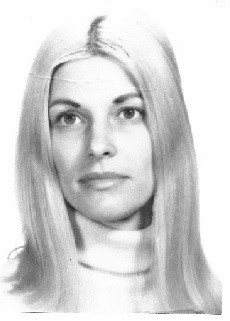 I was born Feb. 27, 1939 and grew up in Queens, NY. My mother, my two sisters and I would go to the public library and fill my red wagon with books. In fact, home was filled not only with books but also music records, which my sisters and I would play. My favorite piece was Bolero.
I was born Feb. 27, 1939 and grew up in Queens, NY. My mother, my two sisters and I would go to the public library and fill my red wagon with books. In fact, home was filled not only with books but also music records, which my sisters and I would play. My favorite piece was Bolero.
I remember reading about famous people who, in spite of personal hardships, managed to change the world. I assume this was the way things were and therefore the turmoil in my life was normal. My mother had to work full time so I was pretty much on my own. I believe that my independent way of thinking had a lot to do with my not having a father at home, which in those days especially was not considered the perfect home life. And so I once stood up at school on an issue that got the class cheering, but resulted in a failing grade for me. But that only reinforced my belief that you had to stand up for what was right and you could be what you wanted.
In a high school music class I was given a French horn, but I had no music training and could play only by ear. I later went to Grover Cleveland High School in Ridgewood, Queens, where I was informed that I was now in the orchestra and we were having a concert that weekend. I was terrified. I went home and tried to remember the notes and what they meant. Nonetheless, I decided I was going to play at Carnegie Hall the next year, having no idea how unlikely this would be. A visiting school music teacher told me if I came in early every morning he would teach me how to read music and horn-playing techniques. The following year I auditioned for the All City Orchestra, made second horn and played the solo French horn part of Bolero at Carnegie Hall before the Mayor and other important people. The concert made the newspapers, with a center picture of the orchestra.
My first moment standing up for women’s rights was in 1964 when I wrote a letter to Procter and Gamble Company protesting their TV ad showing a woman using Tide soap powder and acting as if she didn't have a brain. I received a full-page answer saying "You'll be pleased to note that the ad has been replaced with a new advertising theme. They had received numerous complaints from the public.
Working as a single mother with no childcare or support made me realize where you stand in society. Childcare was viewed as a communist program and was vetoed by President Nixon for that reason. I read of abused and raped women receiving no support from the police and court system. The thought was "she deserved it." The only jobs available to women were clerical and listings were segregated in the newspapers by gender. A woman could not be seated in top restaurants, obtain credit, or rent an apartment by herself, and certain jobs specified "no women." We were thought of as a sub-species useful for producing babies and treated as such. In fact, some male scientists published papers to this notion.
I was lucky to work in the computer field, which was new at that time and businesses needed us. However, I had to stay on top and fight for the raises men received. One outstanding example was when a recruiting firm called me with a job offer implementing an arbitrage system that only a few people on Wall Street were available to accept. The company had the paper work for me to sign without an interview. They called the recruiter and were embarrassed to tell him the manager didn't want women in his department. This went all the way up to the president of the firm who called me at home to apologize. Still no offer. The Equal Employment Opportunity Commission was new and looking for cases. This would have been a slamdunk, but I would never be able to work on Wall Street again if I protested.
1970
In 1970 a woman at the American Stock Exchange where I worked showed me a front page Wall Street Journal article, "Women Strike for Equality," mentioning a meeting being held that night. I felt this incredible revelation.I could now fight for what was right and off I went into the night to attend the meeting, vowing never to return to the injustices dealt to myself and other women.
My life changed radically the night after my first NOW NY meeting in the basement of a church on Central Park West, where women discussed the upcoming "Women’s Strike for Equality" march and how Mayor Lindsay had reduced the parade permit to one lane and left the city. The women yelled "We are marching!” I joined Pat Lawrence and Marion Gannet, who lived in Queens near my home and met them on the morning of August 26. They had with them the now famous "Women of the World Unite" banner they hung off the Statue of Liberty on August 10. Later that day we visited several businesses and distributed feminist flyers to make them aware of their sexist behavior. The businesses had no idea what we were talking about.
THE 1970 MARCH FOR EQUALITY
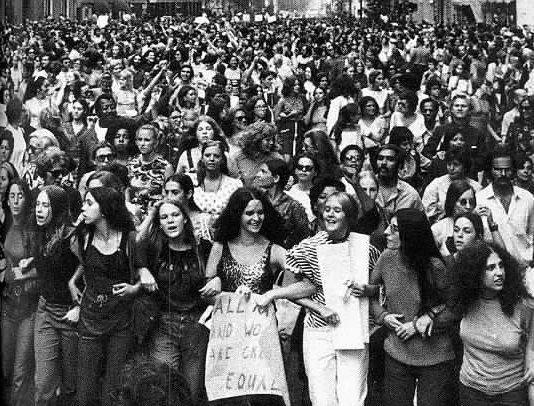 As we gathered on one side of Fifth Avenue and 59th Street on August 26. thousands of women were appearing from all over. I still get chills remembering it. There was a bus of nurses from Connecticut wearing their nursing caps, women with baby carriages, all ages and types of women converging on Fifth Avenue, and entering into the park. We lined up behind the Socialist Workers Party women who had helped plan the march and had experience with anti-Vietnam War marches. We concealed our "Women of the World Unite” banner, since we were concerned the police would seize it.
As we gathered on one side of Fifth Avenue and 59th Street on August 26. thousands of women were appearing from all over. I still get chills remembering it. There was a bus of nurses from Connecticut wearing their nursing caps, women with baby carriages, all ages and types of women converging on Fifth Avenue, and entering into the park. We lined up behind the Socialist Workers Party women who had helped plan the march and had experience with anti-Vietnam War marches. We concealed our "Women of the World Unite” banner, since we were concerned the police would seize it.
Traffic on Fifth Avenue was a chaotic, with cars honking horns and unable to move. A member of the press on a platform cracked, "As usual, women are always late." The Socialist Workers Party women shouted "Start marching and don't stop!” Surging forward behind them, we marched with the banner on to Fifth Avenue with Jacqui Ceballos marching in front of the banner, hollering at us "Move to the left and right with the banner!” and "Don't stop!" The police tried to stop us, but we shouted and chanted "Move on over or we'll move on over you!" until we took over Fifth Avenue with the banner.
The crowds cheered and we marched on. It was exhilarating to see the thousands of people on the avenue. It was at that moment I vowed I would never again let myself and other women tolerate being controlled by government and men. As we neared 41st Street to turn into Bryant Park for speeches, a line of police on horses blocked Fifth Avenue; they had visors pulled down over their faces and held riot sticks they used against anti-war protesters. I asked myself at that moment if I would march through the line for the cause. I thought of the movie Doctor Zhivago, when the peasants marched on the Winter Palace. Thank God I didn't have to make that decision.
We climbed the wall of the Fifth Avenue Library on 41st Street and held up the banner. We were told later the marchers were unhappy when they saw the police blocking Fifth Avenue, but as they turned on to 41st Street and saw us, they thrust their fists in the air and cheered.
1971
In August 1971 I went to the NOW office in Manhattan and asked Jacqui Ceballos what I could do. She said there was an employment meeting going on in the other room and to just go in. They were discussing what they could at the next march coming up that month to show how women were discriminated against in employment. I told them of my fantasies of shutting down Wall Street to bring attention to discrimination through the media. I had worked for the Stock Exchange and a bank and knew how the system worked. They said "Great!" We then developed what became known as "Zap Actions." But it is one thing to dream up these ideas and another to make them work and not get arrested. We met at *Grace Jackson's apartment and painted the now famous "Women Power" banner. Each letter matched the size of the balcony windows at the American Stock Exchange, which I had measured the week before. So we could get into the Stock Exchange, I signed us up the week before as a garden club, since Wall Street was cautious of the anti-war demonstrators.
On August 26 we met at Broadway and Wall Streets and marched over to the American Stock Exchange. I ran across the balcony with the banner I had concealed under my coat to gain admission and we pushed each letter against the glass, chanting, "We can't bear any more bull!" The ticker stopped ticking, since the brokers were busy booing us--and then cheering us--and thus stopped trading, as I knew they would. We had a van cruising earlier around Wall Street calling out "Women have taken over Wall Street!" We then marched and took over the Treasury steps. Thousands filled Wall and Broad Streets to see the "radical women."
We then proceeded to liberate the "men only" Tom Brown’s Bar," singing "Roll out the Banner" as we entered carrying the banner to the shock of the male patrons. On Sunday we had nailed to the bar door the newly passed City Law prohibiting discrimination by public businesses. Later we marched down Fifth Avenue with our "Women Power" banner. That day I earned the title "General" from the protesters. We kept the press busy that day.
1972
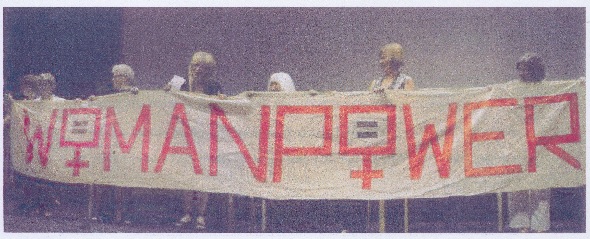 The following year, also on August 26th, we hung the "Women Power" Banner on the Statue of Liberty and then proceeded uptown to demonstrate at the Park Avenue Citibank, where we had opened savings accounts with two dollars weeks before. I entered and ask for a female Vice President, knowing they didn't have any. I then waved my bank account book--which I still have--and yelled "Citibank has no female Vice Presidents!" Feminists posing as customers on lines turned to each other and loudly exclaimed, "Did you hear that? I am closing my account." The bank officers went crazy, locking the doors to keep people out, calling the police, and trying to figure out what was happening. We proceeded to the teller windows to close our accounts; one teller asked, "would you like dollars or coins?" Outside, we held up our signs and banner and chanted "Give credit where credit is due!" Later I was told that a Hollywood movie with Charlton Heston used the scene. That year I was chair of Wall Street Women Unite, a group I created. In 1975 I conceived the idea for a Women’s Bank and was a member of the Advisory Board of Directors and worked with a group of women to form a Feminist Credit Union.
The following year, also on August 26th, we hung the "Women Power" Banner on the Statue of Liberty and then proceeded uptown to demonstrate at the Park Avenue Citibank, where we had opened savings accounts with two dollars weeks before. I entered and ask for a female Vice President, knowing they didn't have any. I then waved my bank account book--which I still have--and yelled "Citibank has no female Vice Presidents!" Feminists posing as customers on lines turned to each other and loudly exclaimed, "Did you hear that? I am closing my account." The bank officers went crazy, locking the doors to keep people out, calling the police, and trying to figure out what was happening. We proceeded to the teller windows to close our accounts; one teller asked, "would you like dollars or coins?" Outside, we held up our signs and banner and chanted "Give credit where credit is due!" Later I was told that a Hollywood movie with Charlton Heston used the scene. That year I was chair of Wall Street Women Unite, a group I created. In 1975 I conceived the idea for a Women’s Bank and was a member of the Advisory Board of Directors and worked with a group of women to form a Feminist Credit Union.
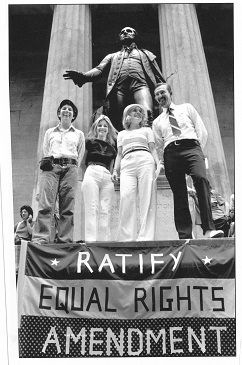 Doris Rush (feminist attorney and NOW member) and Nancy Borman (editor of Majority Report) and I put together an FBI (Feminist Bureau of Investigation) poster with pictures of ten corporate men sought for crimes against women. I had gotten their pictures and private phone numbers from an inside feminist source and we put them under their photos like mug-shot numbers. The text said to proceed with caution as they were known to discriminate against women and hide out in private clubs.
Doris Rush (feminist attorney and NOW member) and Nancy Borman (editor of Majority Report) and I put together an FBI (Feminist Bureau of Investigation) poster with pictures of ten corporate men sought for crimes against women. I had gotten their pictures and private phone numbers from an inside feminist source and we put them under their photos like mug-shot numbers. The text said to proceed with caution as they were known to discriminate against women and hide out in private clubs.
At midnight, before the 1972 August 26 march we arrived at Wall Street in a car whose license plate was covered in mud to conceal the number. We wore wigs, carried pails of paste, and posted the walls in the Wall Street area and other parts of Manhattan. People arrived at work the next morning and we were told that some thought the posters were real. (The Washington DC NOW chapter later did the same.) This resulted in a FBI file on me that the FBI denied having when I filed a FOI request. Several years later, however, a newspaper reporter showed me an FBI report they found on me in a FOI request they had filed on the women’s movement. The FBI report said that a congressman from Georgia wanted me arrested for sedition. The Justice Department said they didn't think it was a good idea because “it would lead to more actions and publicity." Good thing I put an asterisk at the bottom of the poster "*Feminist Bureau of Investigation." Those were heady days.
1974
In 1971 Glamour magazine had written an editorial on credit discrimination, and asked readers to send their stories to me at NOW. It resulted in a huge outpouring of letters. In 1974 I testified before the Congressional Banking Commission—opposite then Federal Reserve Chair Arthur Burns, who denied the existence of discrimination in credit against women. Yet HUD at that time—unimaginable now—required of couples with two incomes applying for mortgages proof of the woman’s sterilization on grounds that a woman might become pregnant by a male other than her husband. I testified "Banks are stepping into the bedrooms of America." (In 1975 federal legislation would officially ban such discrimination.) For this work, I would be honored in 2005, along with four other women, by Glamour in its 800th issue as one “who has significantly enhanced the freedoms of American women.”
In 1974 I became President of NOW NY for two terms and served on the National Board, where I headed the National Women's Equality Action Day and Credit Discrimination Committees. The NOW Chapter held several demonstrations and work shops covering multiple issues, such as abortion, rape, employment, and sexuality. Practically every night the chapter had a committee or planning session going on. The women I worked with in the chapter—Elaine Sydner, Denise Fuge, Noreen Connell, Ann Jarwin, Anita Murray, Midge Kovak, Judith Kaplan, Dell Williams, Yolanda Banko, Joyce Synder, Mary Vasiliades, Barbara Rockman, and many others—were incredibly dedicated and were responsible for the changes young women now take for granted.
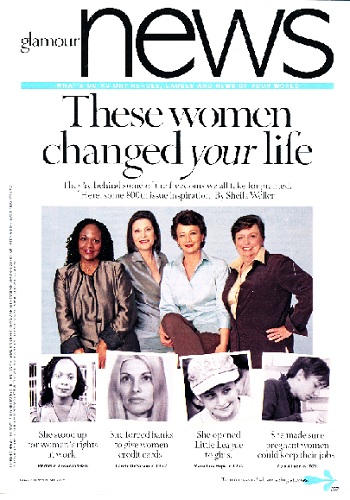 I called for a hearing against the State Human Rights Commission for not giving unemployment benefits to pregnant women who were fired and had their unemployment books stamped with a P; the ultimate result was that the practice was eliminated. Later I served on the NYS Human Rights Commission Advisory Council. I participated with the National Council of Churches in 1974 on Stockholder actions against corporations calling for equal employment of women and minorities. We were successful with the Chicago NOW Chapter when they brought to the floor resolutions calling for change and the Celanese Corporation when Joann Hull, an employee and NOW NY member, Betty Harragan, and I stood up and read resolutions. Both chairmen behaved so badly toward us that they had to later publicly apologize in the press.
I called for a hearing against the State Human Rights Commission for not giving unemployment benefits to pregnant women who were fired and had their unemployment books stamped with a P; the ultimate result was that the practice was eliminated. Later I served on the NYS Human Rights Commission Advisory Council. I participated with the National Council of Churches in 1974 on Stockholder actions against corporations calling for equal employment of women and minorities. We were successful with the Chicago NOW Chapter when they brought to the floor resolutions calling for change and the Celanese Corporation when Joann Hull, an employee and NOW NY member, Betty Harragan, and I stood up and read resolutions. Both chairmen behaved so badly toward us that they had to later publicly apologize in the press.
In 1975 the United Nations held an International Women's Conference in Mexico City. I was there and disrupted the U.S./Mexico City Embassy's presentation of U.S. Women Representatives to demonstrate that U.S. government's choice of official representatives to the conference reflected the male mentality on women's issues. The photographer, Bettye Lane was present with me and took pictures of the Marines moving toward us and the startled U.S. representatives. I was quoted in the Sunday New York Times front page, world news media, and several publications: "The true issues, the problems of women are being forgotten here. Instead this conference is concentrating on political issues that represent the male mentality. The direction here is not coming from women, its coming from men." Jacqui Ceballos, Betty Friedan, I , and other American women were caught in the anti-American tone at this International Women’s Year event. The political intent was to keep women from uniting. I put together an "East Meets West " speak-out with Jacqui, Betty, a Chinese reporter, and myself on the dais. At first there were negative words aimed at us, but then the women realized we all had the same problems and they began to share with us their experiences. When we returned to New York we held a press conference and the New York Times devoted a full page to the event and quoted me: "Women did unite." Several years later our picture along with an account of the proceedings in Mexico appeared in a China magazine. Betty Friedan’s book It Changed my Life has a chapter ("Scary doings in Mexico City") that describes the dangerous situation we were in. I was happy to get back home alive.
I had worked for Smith Barney and the American Stock Exchange as a Computer Systems Analyst and earned my B.A. in Political Science and Economics at Columbia University while working full-time. I rose to Assistant Vice President at Chemical Bank in the seventies while involved in pioneering computer projects with IBM. I left the bank in 1981 to serve as Commissioner of the Treasury of New York City under Mayor Ed Koch and later left for a career in real estate sales.
I became active in community affairs in Tribeca when I moved there in 1974. Later I became chair of Community #1, which covers Wall Street and Tribeca. My women’s movement experiences allowed me to take on developers in the 1980s. This led to forming The Tribeca Community Association, of which I became Chair, which spearheaded the campaign to make Tribeca an Historic District and brought about the rediscovery and restoration of the Canal Street Park.
On December 7, 2001, the Redstockings launched the book New Women's Liberation Offensive at my Tribeca loft. It was exhilarating to see Carol Gaudina, Kathy Sarachild, and others still going strong with new young women joining our ranks. We marched together in the anti Iraq-war march in Manhattan. Later Dell Williams had a book signing event at my loft resulting in the “Women Power” banner being included in the Passion and Power film by Wendy Slick and Emiko Omori. The banner was later displayed by us on stage at the movie’s premier at the Walter Reed Theatre at Lincoln Center.
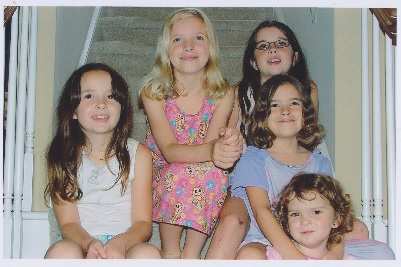 |
|
Carole's five granddaughters |
In 2010 I spoke before the Women’s Leadership Initiative at Yale's Pierson College on my participation in the fight for women’s rights and cautioned them not to be complacent about gender equality. Later at a faculty dinner the audience became engaged when they realized how far women had come and how outrageous the injustices toward women were in the past.
In 1978 I had met my musician-scholar husband Raymond Erickson, formerly Dean of the Arts and Humanities at Queens College; he has supported me in all my activities, spoken out publicly on the ERA, and attends NOW functions. We are currently restoring the exterior and remodeling the interior of a historic Hudson Valley village church, now our home; the building is on the National Registry of Historic Buildings. My daughter Lisa and son Douglas were supportive of my involvement in the women's movement. I now have five granddaughters who are quite outspoken and actively work to make things better in our world. I feel happy they are ready to stand up for injustice and for the values I believe in.
I want to thank the dynamic, true, feminist women I have met over the years through the women’s movement. They profoundly changed my life, enabling me to direct my energy at combating injustices and toward positive avenues for change. Now, working with the Veteran Feminists of America and especially Jacqui Ceballos, Muriel Fox, Barbara Love and others, has given me the energy to keep working for what is right for women. To them I say thank you from the bottom of my heart. You are all wonderful.
Contact Carole DeSaram: desaram50@earthlink.net
Comments: Jacqui Ceballos jcvfa@aol.com